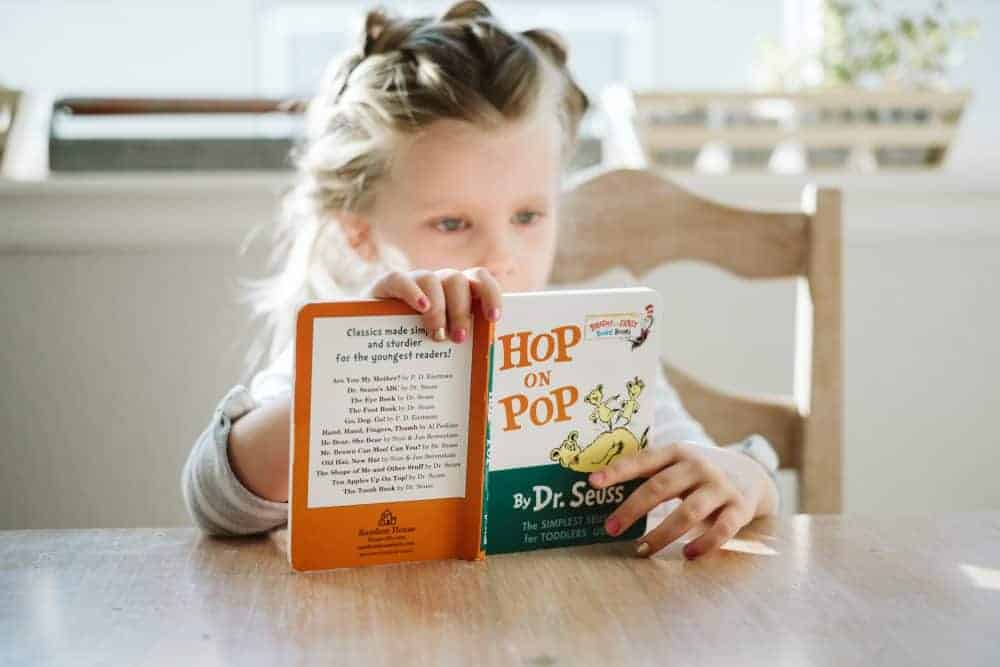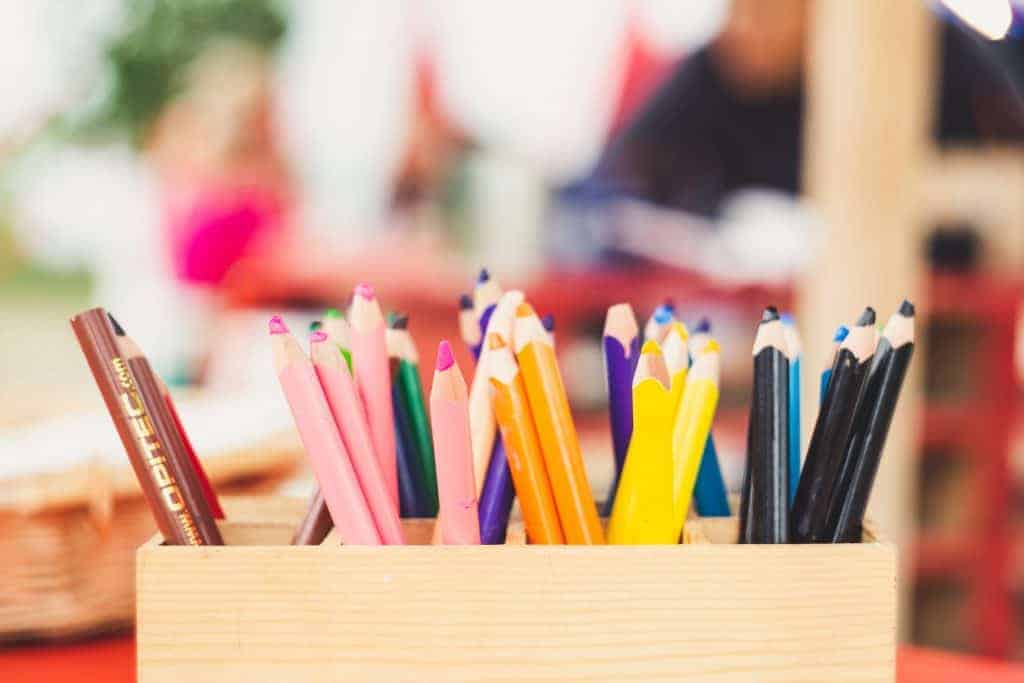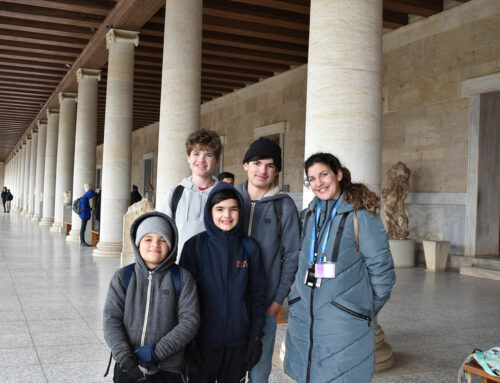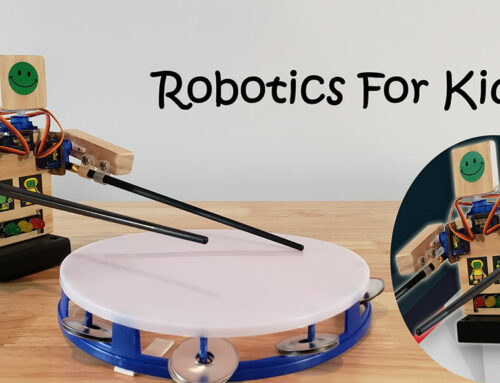by Dawn Michelle Michals
This is it! You’ve taken the leap to homeschool kindergarten. You and your five-year-old are gearing up for a successful year! We have everything you need for homeschooling at the kindergarten level. Developmental milestones, competencies, field trip ideas, and more are all listed below.
Homeschooling curriculum in the state of Texas must include the five basic subjects of reading, spelling, grammar, mathematics and good citizenship. Science, history, and social studies are included below for you.
Not in Texas? Check out state requirements for homeschooling first grade in your state.
By age five, children are able to recognize their names in print, begin to recognize many upper and lower case letters, and even begin recognizing words they know from signs, labels and billboards. Below is a list of kindergarten competencies by subject.
Read ahead:
Suggested School Supplies for Kindergarten
- Pencils
- Pencil sharpener
- Lined paper
- Binders
- Crayons and colored pencils
- Paints (tempera and watercolor)
- Paintbrushes
- Paper for painting
- Construction paper
- Whiteboard
- Dry erase markers
- Ruler
- Children’s scissors (blunt tip)
- Glue sticks
- White glue
- Tape
- Math manipulatives
- Globe
- Wall maps of the world and the United States
- Library card.
Kindergarten Milestones by Subject
Kindergarten Language Arts
- Uses sentences that include two or more ideas
- Uses descriptive language
- Knows by heart and recites favorite nursery rhymes and songs
- Pretends, creates, and makes up songs or stories
- Tells or retells stories and/or everyday experiences
- Asks questions and expresses curiosity
- Expresses ideas so that others can understand
- Recognizes and names basic colors
- Draws recognizable shapes and simple objects
- Tells a story with pictures
- Understands concepts of in/out, under/over, on/off, front/back, etc.
- Describes how objects are the same or different.

Kindergarten Reading
- Pretends to read books by reading the pictures and begins to look at books on his or her own
- Begins to read in everyday situations (signs, labels, etc.)
- Recognizes rhyming words
- Blends letter sounds into words
- Recognizes some common words in print
- Recognizes many uppercase and lowercase letters
- Recognizes some letter sounds
- Describes characters’ actions and feelings in a story
- Relates stories to personal experiences
- Puts events of a story in order.
Kindergarten Writing Skills
- Attempts to write own name and can recognize own name in print
- Tries to write, scribble, or draw
- Asks you to write words or notes to others.
Kindergarten Math
- Compares the size of groups of objects using language such as “more,” “less” and “same as”
- Arranges objects in size order (big to small or small to big)
- Uses comparison words, like “bigger,” “smaller,” “heavier,” etc.
- Understands concepts of none, some and all, and more than and less than
- Identifies and draws a square, circle, and triangle
- Correctly counts four to 10 objects
- Knows that the final number counted represents the total number of objects in a set
- Recognizes numbers one through 10
- Can distinguish numbers from letters and understands that numbers relate to quantity
- Understands the effects of addition and subtraction
- Matches or groups objects according to size, shape, or color
- Groups objects that are the same.
Kindergarten Science
- Shows interest and asks questions about objects and events observed in his or her environment
- Notices common properties and differences among objects and materials
- Knows some facts about common plants and animals, such as what they eat and names of baby animals
- Recognizes some objects in the sky such as the sun, moon, clouds, and lightning
Kindergarten Creative Arts and Music
- Able to move to the beat of the music
- Explores with common musical instruments
- Enjoys improvising or copying musical patterns.
Kindergarten Social Studies
- Recognizes basic traditions such as birthdays
- Shows an understanding of the passing of time, including concepts of before and after, and today, yesterday, and tomorrow
- Explores simple maps and visual representations of neighborhoods or communities
- Understands that people live in different parts of the world and have different customs and traditions.
Kindergarten Social Skills
- Adjusts to new situations
- Attempts new tasks knowing it’s okay to make mistakes
- Shows pride in accomplishments
- Follows simple directions
- Stays with an activity to completion
- Asks for help
- Interacts appropriately with adults and peers
- Takes responsibility for own belongings (lunch, coat, etc.)
- Adheres to a routine and schedule for personal hygiene, eating meals and going to bed
- Uses good hygiene habits and table manners
- Uses appropriate bathroom skills
- Follows simple safety rules
- Offers to help peers and family
- Respects the rights, property and feelings of others
- Works cooperatively (listens to others, shares and takes turns)
- Demonstrates increasing self-control
- Participates in clean-up activities.
Kindergarten Good Citizenship
It’s never too early to discover what it means to be a good citizen. Not only are understanding our right to vote and the privileges of citizenship important, but also respect for our planet, good stewardship, and discerning the world around us. Here are some great ideas for teaching good citizenship in your homeschool.
Additional ideas:
- Become involved in events and initiatives such as Capitol Days (sponsored by THSC).
- Attend rallies of causes you believe in as a family.
- Register to vote and vote! Take your child with you to see the process. Children under the age of 18 are allowed to go with you and even go inside the booth with you in every state in the United States.
- Keep our state clean by picking up litter.
- Learn about recycling and where and how you can recycle items in your town.
Five-Year-Old Developmental Milestones
By age five, your kindergartener is becoming a little more independent, a little more outspoken, and a lot more knowledgeable of the world around him. Below is a list of milestones that are easily identified by age five.
Remember, all children develop at different rates. If you have concerns about your child’s development after reviewing this list, please discuss those with your healthcare provider.
Five-Year-Old Gross Motor Skills
- Jumps, hops, and skips
- Walks backward
- Walks heel-to-toe without losing balance
- Runs on toes
- Able to get up without using hands
- Balances on alternate feet (eyes open or closed)
- Catches a ball using hands more than arms
- Jumps rope
- Jumps down several steps.
Five-Year-Old Fine Motor Skills
- Grasps a pencil correctly
- Begins to print her name and can print some letters or numbers
- Can draw a person with at least six body parts
- Copies a triangle and other geometric shapes
- Uses a fork and spoon, and sometimes a table knife
- Gets dressed and can tie shoes
- Cuts out a circle
- Opens a lock with a key
- Draw a diamond shape when given a model
- Talking and Understanding
- Speaks very clearly and in complete sentences.
- Able to say full name and address
- Uses words to solve problems or conflicts, articulates feelings in words
- Uses words like please, thank you, and excuse me
- Uses full sentences to tell a simple story
- Uses future tense; for example, “My friend will be here.”
- Able to count 10 or more things
- Has an understanding of things we use every day, such as money and food
- Wants to please friends and be like them (mimics behavior)
- Is aware of gender
- Likes to sing, dance, and act
- Can tell what’s real and what’s make-believe
- Shows more independence
- More likely to agree with rules
- Is sometimes demanding and sometimes very cooperative.
Homeschool Kindergarten Resources
10 Great Kindergarten Books or Series
Find these books at your local library or find them at any bookstore. If you shop on Amazon, please visit Amazon Smile and choose Texas Home School Coalition as your charity of choice!
We also recommend checking with a site such as Redeemed Reader or Plugged-In as to the appropriateness of any particular book for your child and their personal maturity level.
Another wonderful place for book recommendations is The Read-Aloud Revival, which features booklists and reviews for all kinds of books and reading levels.
- Dr. Seuss: The preeminent author of juvenile fiction weaves together life lessons, cultural diversity, environmental science, and stage-appropriate vocabulary
- P. D. Eastman: A protege of Dr. Seuss, provides large print and fun illustrations in his stories that children have enjoyed for generations
- Now We Are Six: In this classic and simple introduction to poetry, A.A. Milne writes whimsical and childlike lines – some featuring Christopher Robin and Pooh – that perfectly capture the mindset and the beauty of childhood. Ernest Shepherd’s illustrations add just the right touch.
- Chicka Chicka Boom Boom: find out what happens when all of the letters try to climb the coconut tree in this book by Bill Martin Jr. and John Archambault (illustrated by Lois Ehlert).
- Harold and the Purple Crayon: how far can Harold’s imagination take him? With his purple crayon in hand, Harold creates magical worlds and twists and turns in this book (written and illustrated by Crockett Johnson).
- Leo the Late Bloomer: when Leo isn’t reading, talking, or drawing like the other children, Leo and his father become concerned, but his mother’s not. She knows that Leo is just a “late bloomer.” This endearing book by Robert Kraus and Jose Aruego shows that children learn at their own pace.
- Miss Nelson is Missing!: when a group of rowdy school children drive their teacher to her wit’s end, substitute teacher Miss Viola Swamp (known as “the meanest substitute teacher in the whole world”) helps the children discover how much they really do like Miss Nelson. Who is Miss Viola Swamp, and where did Miss Nelson really go? Harry Allard’s and James Marshall’s hilarious words and illustrations will entertain you until the end!
- The Story of Ferdinand: a sensitive, peaceful Ferdinand prefers sniffing flowers under his favorite cork tree than snorting, leaping, and head-butting with the other young bulls. Written by Munro Leaf and illustrated by Robert Lawson. This book opens up conversations about self-respect and honor, as well as standing up for what you believe in.
- Madeline: this beloved Caldecott Honor Book (1940) by Ludwig Bemelmans tells the story of a seven-year-old girl attending boarding school in Paris under the care of Miss Clavel. For almost 80 years, “Madeline” has brought rhythm and rhyme to households around the world.
- Tikki Tikki Tembo: author Arlene Mosel and illustrator Blair Lent share the story of Tikki tikki tembo-no sa rembo-chari bari ruchi-pip peri pembo, a boy with a super-long name. This re-telling of an ancient Chinese folktale is sure to delight both you and your young reader.
- Mike Mulligan and His Steam Shovel: learn about Mike and his steam shovel “Mary Anne” in this classic by Virginia Lee Burton, first published in 1939. Will Mary Anne be saved from the scrap heap? Discover how friendship, hard work, and ingenuity can save the day.
Homeschooling Kindergarten Websites
- HomeEducator.com: This site is brought to you by THSC and offers resources for parents, student learning and a free biweekly newsletter.
- Education.com: Worksheets, science experiments, crafts and more!
- TeachersPayTeachers.com: Free and paid resources created for teachers by teachers.
- YoungExplorers.com: Creative educational products.
- PBSLearningMedia.org: Free videos, lesson plans and other digital resources for early elementary students.
- NASA.gov: Games and resources to teach science, technology, engineering and mathematics (STEM).
10 Kindergarten Field Trip Ideas
Especially in kindergarten, field grips don’t have to be fancy. Everyday situations (like taking a pet to the vet) serve as great field trips!
Field trips also don’t always mean a trip in the car. Take an imagination field trip around your neighborhood or backyard. What do you see? Makeup stories about what the bugs are doing. Tell stories to each other and broaden everyone’s imagination.
Want to get out and go? Here are some ideas scattered throughout Texas to keep you and your eager homeschoolers engaged and learning.
- First Responder Appreciation: Police, fire and EMS stations are located throughout most cities. Locate the one closest to your house and make a connection. Tour a fire station, talk to a police officer or reach out to an emergency medical technician and find out what it truly means to be a first responder.
- Government: THSC Capitol Days are one-day, hands-on events that allow homeschooling families to fully participate in the state legislative process. These events give the opportunity to defend the rights of homeschool families in Texas, meet representatives and staff, and actually help pass a law.
- Picnic at a pond. Ducks, fish, ecosystems, conservation, recycling, picking up trash, and using less plastic is just a sampling of the topics that may come up while visiting a pond. Bring a lunch and enjoy some time outside together.
- Visit our state capitol: the Capitol offers daily tours as well as a free grade-specific guide, which includes history, architecture, and the legislative process. This kindergarten-specific tour meets several social studies requirements!
- Legoland: Fine-tune those fine and gross motor skills at Legoland Discovery Center in Grapevine. They even offer a homeschool week each February. Includes educational stations that use LEGOs to learn math, science, and engineering.
- Ride a train: Bring a child’s fascination with trains to life by visiting the Grapevine Vintage Railroad. Forty-five-minute to five-hour excursions is available. Due to excessive freight-train traffic, it is advised that you check their Facebook page for day-to-day updates and cancellations.
- Theater/Music/Art: Get front-row seats for a theater performance or grab a blanket and head to a free outdoor concert. Stroll through a sculpture garden. Music, art, and theater will open your child’s mind to other worlds and experiences. Attend a performance by a children’s theater for added inspiration.
- Agriculture: Head to Marble Falls and tour Sweet Berry Farm during the spring and fall seasons and pick fruit, learn about growing food, and take a turn through their Texas-shaped corn maze available each fall.
- Texas history: Nothing says “We’re in Texas!” better than a trip to the National Day of the Cowboy held each July in the Stockyards National Historic District in Fort Worth. Free activities include chuckwagon poetry, a quick draw contest, face painting, armadillo races, and live western music. There’s also a youth fiddling contest, a BBQ rib eating contest as well as the Fort Worth Herd Cattle Drive and Western Parade,
- Road trips: Get in the car and go! For more Texas road trip ideas (and beyond), check out our roadschooling page!
Homeschooling kindergarten is one of the best ways you can give your child a love for learning. And if your child loves learning, she will continue to be curious about the world around her and explore long after graduating. Have fun this year!
We believe homeschooling is one of the best educational models, which is why we support families with encouragement and practical resources like you found in this article. Won’t you join us in making these resources available to homeschooling families by becoming a member?





This is really useful. How/where do I register my child for the homeschool?
Dear Venkadeson,
Parents serve as the school official in your homeschool; homeschools happen in and through your home! THSC is not a school or an umbrella program. We are a member supported organization that provides help, resources, and advocacy to support your homeschool. Joining THSC connects you with many benefits, including discounts on curriculum, homeschool organization templates, legal assistance, and more. Member families should be Texas residents that homeschool their children. Texas families can use any curriculum they choose, even if they reside temporarily outside of Texas, however, we do not provide legal assistance for families who are not residents of Texas.
To better understand homeschooling: Review Texas Homeschool Laws. Knowing the difference in homeschooling and public, private, charter, online public school, or online private school, will help you feel more equipped to educate at home. Parents oversee the education for their child and your transcript and diploma are legal. Read: Definition of a homeschooled student.
It is recommended to research prospective schools and programs; ask for references, and check online reviews. Be sure the school or program will meet the needs of your family, comply with Texas Homeschool Laws, and will provide your student with what they need for whatever they plan to pursue after they graduate.
Blessings, Ashley – Customer Relations
Hello! I have a 4 year old who is genuinely ahead in all of these metrics. We jokingly refer to him and his older brother as Sheldon and Leonard. With this said, we’re disappointed that he cannot participate in kindergarten due to his birthday being October 1st of this year. In our home state of Nevada, we would have been able to take him to his local school and have an exception made when evaluated as we did with his older brother. All of our boys miss the Nevada kindergarten cute off by 1 day. So in Texas it’s been a different experience for public school as it’s a whole month earlier than the Nevada cutoff. We’ve decided to begin homeschooling for our younger son, but if we decide to transition back to public school at some point, will he be held back due to his age? Just wanting to get all of our ducks in a row and how to be prepared to request this down the road.
Dear Jocelyn,
School districts set the requirements for entry into their schools. This is a local decision, not one made by the state of Texas. However, the TEA Commissioner’s letter to the school administrator states “with respect to the awarding of transfer credit from students who have been home schooled. Under Title 19, Texas Administrative Code (TAC), §74.26(a)(2), students transferring from home schools should be afforded the same treatment as students transferring from unaccredited private schools. Awarding of credit for courses taken may be determined by reviewing the curriculum and/or work of the student, or by using appropriate assessments.”
There may be options to ask for a placement test to accelerate your child, but you may need to work with the district to ask for this; and use the TEA letter to help you with that: https://tea.texas.gov/about-tea/news-and-multimedia/correspondence/taa-letters/home-schools
The letter also has suggested placement tests for school when those are used. It is recommended to read the TEA Commissioner’s letter and show this to your school if they are not aware of these guidelines. Learn more on our website: Requirements & Comprehensive FAQs at https://thsc.org/requirements-to-homeschool-in-texas/
Choose: Enrolling in public school after homeschooling in Texas
How to homeschool in Texas: https://thsc.org/how-to-homeschool-texas/
Find the TEA Commissioner’s letter: https://tea.texas.gov/about-tea/news-and-multimedia/correspondence/taa-letters/home-schools
If the school does not operate under this criteria and you are a THSC member, we can review the issue and might be able to intervene to help you further (must be a THSC member). View the TEA Commissioner’s Letter: https://tea.texas.gov/about-tea/news-and-multimedia/correspondence/taa-letters/home-schools
I hope this helps.
Blessings, Ashley – Customer Relations